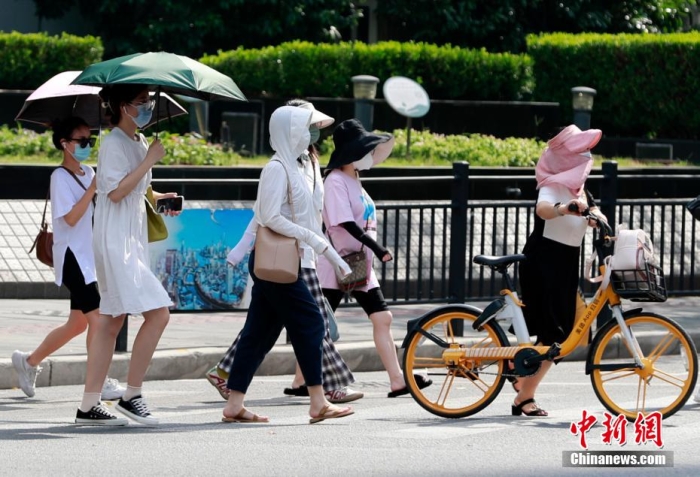China News Agency, Beijing, July 14. Since the beginning of summer, many places in China have been hit by heat waves.
According to statistics from China Weather Network, as of 14:00 on July 14, more than 80 counties (cities, districts) in Zhejiang, Shanghai, Chongqing, Sichuan and other places have high temperature red warning signals in effect.
Data map: Passers-by "show their magical powers" to avoid the hot sun.
Photo by Tang Yanjun
Under the heat wave, a hollow sycamore tree by the roadside in Hangzhou emitted white smoke. After receiving the alarm, the firefighters filled the trunk with water and then "turned off the fire";
The asphalt layer on the roof of the Memorial Hall of Cultural Relics Relocated to the South of the Forbidden City in Chongqing was "sunburned", causing the tiles to fall off, and the museum had to be temporarily closed;
The highest temperature in Shanghai reached 40.9°C on July 13, tying the record for the highest temperature in history since meteorological records began in 1873;
In Changzhou, Jiangsu, a truck driver called 119 for help, saying that the two trucks of live pigs he was carrying were "hot."
After the firefighters arrived, they set up water cannons to cool off the heat.
After 20 minutes of showering and cooling down, the "Second Senior Brothers" became active again.
The Yangtze River Delta and Sichuan-Chongqing regions are sunny and hot during the day and unbearably hot at night.
At around 5:25 on July 13, the lowest temperature in Shapingba, Chongqing reached 33°C, breaking the highest record of the lowest temperature since local observation records.
Netizens sighed: "It's hard to breathe day and night, tossing and turning like a steamer."
Extremely severe heat stroke "heat stroke" also appeared on the social media hot search list.
According to The Paper, a number of hospitals in Zhejiang have recently sent heatstroke patients to the hospital in succession. Many people have been diagnosed with heat stroke and have died. Some people in Nanjing and Sichuan have also been diagnosed.
The high temperature has caused a rapid increase in China's electricity consumption.
Li Yunqing, director of the Economic Operation Adjustment Bureau of the National Development and Reform Commission, revealed on July 14 that due to factors such as the increase in electricity consumption in key industries and rising temperatures, China's daily power generation has risen rapidly since the beginning of summer. On July 13, the national dispatched power generation reached 278.54 100 million kWh, and the highest dispatched load reached 1.222 billion kW, both hitting record highs.
According to the National Climate Center, since June 13, China has experienced the first regional high temperature weather process this year, with a wide range, long duration, strong extremes, and great impact. As of July 12, the high temperature event has lasted for 30 days. It covers a land area of 5.021 million square kilometers and affects a population of more than 900 million people.
The heat wave not only ravaged China, but also swept the northern hemisphere.
According to the monitoring of the National Climate Center, in June this year, the global average temperature was about 0.4°C higher than normal, the highest since 1979, among which northern Russia and western Europe were more than 2°C higher.
Why is this round of high temperature so fierce?
China Weather Network meteorological analyst Wang Weiyue said that the strong subtropical high pressure is the driving force behind this round of high temperature and hot weather in the south.
At present, the position of the subtropical high is more norther than the same period of the previous years, and its intensity is also stronger, and it has controlled the eastern Sichuan Basin to Jiangnan, northern South China and other places for a long time.
In addition, the warm and humid airflow is strong, the air humidity is high, and the body feels like steaming and boiling, and the heat is unbearable.
According to the National Climate Center, since the beginning of the 21st century, high temperature and heat waves in the northern hemisphere have become more frequent in summer, and global warming is the root cause.
Specifically for China, the ongoing La Niña event has provided important climatic background conditions for the occurrence and development of high temperature in the south since June. In particular, the development of the mid-latitude warm high pressure belt intensified in July, resulting in the occurrence of large-scale high temperature weather.
The good news is that this round of high temperature will usher in a "intermission" in the next few days.
The Central Meteorological Observatory predicts that from the 17th, there will be rainfall in the Sichuan Basin, and the high temperature weather will weaken.
On the 18th, the surrounding areas of the Yangtze River Delta may usher in rainfall, and the high temperature weather has eased, but the high temperature and muggy weather will continue in the southeast of Jiangnan and eastern South China.
However, after July 21, the high temperature in the southern region will develop again and the scope will expand. The daily maximum temperature in Fujian, Jiangxi, southern Zhejiang and other places can reach 39°C to 41°C.
Meteorological experts reminded that in high temperature weather, pay attention to adequate rest, replenish water in time, reduce going out in the afternoon, scientifically prevent heatstroke and cool down, and spend the summer safely.
(Finish)

